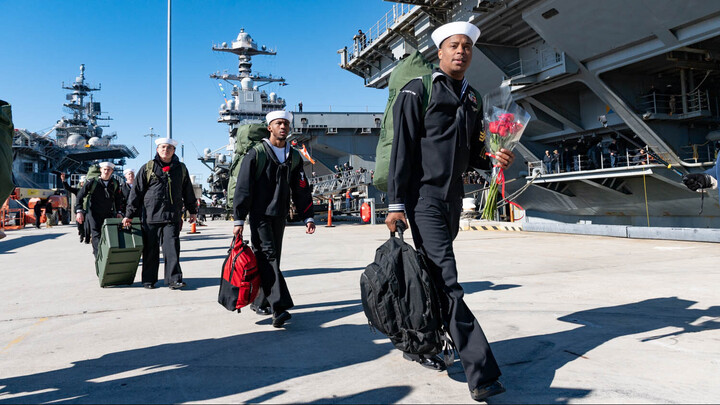
Sailors from the USS Gerald R. Ford arriving in Norfolk. Jan. 17, 2024. Zach D. Roberts

Nekaha Taylor, of Virginia Beach, waved to her daughter Chief Petty Officer Dominique Taylor standing on the USS Gerald R. Ford while her other daughter and son waited in the cold Wednesday.
“She wants to get away. She says she will stay in her room because she's been around 4,000 people for all these months. That's her plan and we support that,” Nekasha Taylor said of her daughter.
The USS Ford left Norfolk May 2, 2023 for what was supposed to be a six-month deployment to Europe. They were extended twice. The second time meant Dominique would not be home for the holidays.
“I wanted to go get my baby. And I was really upset, but I'm happy she's home,” Nekesha Taylor said.
Early in its deployment, the United State’s newest and largest aircraft carrier made multiple stops in the Baltic near the Arctic Circle, Europe and the western Mediterranean. The Ford hosted NATO allies and made stops in Turkey, Norway, Greece, Montenegro and Italy, continuing a show of support by U.S. carriers that started after war broke out in Ukraine.
For the first six months, the carrier was out at sea for days at a time, followed by extended port visits.
The nature of the deployment changed abruptly after war broke out in Gaza. The Ford was moved to the eastern Mediterranean, off the coast of Israel. The carrier was extended twice by Secretary of Defense Lloyd Austin until it was called home Jan. 2.
“I couldn't change the fact that I couldn't bring them home,” said Rear Adm. Erik Eslich, the Strike Group Commander. “But I can only say thank you because they did such a tremendous job. We really felt the support.”
On December 20, Secretary of Defense Lloyd Austin visited the Ford in the eastern Mediterranean Sea, and thanked its crew for their role in helping prevent a broader conflict in the Middle East.
Monday, Navy Secretary Carlos Del Toro flew out to the carrier to congratulate the crew before they arrived back in Norfolk.
“Our Navy should be filled with pride as this ship pulls back into Norfolk, Virginia, after an eight- month deployment where they have protected our national security interests in the Mediterranean, the Baltic and the Atlantic,” Del Toro said. “And they have performed superbly and on every level.”
With their arrival in Norfolk, the crew will get at least two weeks extended leave before the Navy’s newest carrier begins working up for its next series of exercises.
After war broke out between Israel and Hamas in October, another Norfolk-based carrier, the USS Dwight D. Eisenhower was deployed to the Red Sea. The Ike’s strike group has been engaging with Houthi rebels in Yemen, which have disrupted international shipping in the region.
During its time off the coast of Israel, the Ford did not encounter drones or missiles. Its squadron of F18 Super Hornets did not participate in strikes in Yemen or pursue targets in the Red Sea, said Captain Rick Burgess.
The carrier spent its longest time at sea, launching more than 10,000 aircraft. More than a quarter of the sorties happened after the ship arrived off the coast of Israel.
“I would just like to build on all the successes that we gleaned from this past deployment. Again, it's such an extraordinary ship, and it's so different,” Burgess said.
The Ford the first of its class. The carrier is designed to be more automated and deployed with 400 fewer crew members than the smaller Nimitz class carriers, like the Eisenhower.
The Ford was built by Huntington Ingalls Newport News Shipbuilding, which is currently building two more Ford Class carriers.
The USS Ford was accepted by the Navy in 2017. Before this deployment, the high tech carrier earned most of its headlines because of cost overruns and technical issues with some of its new systems, including an electromagnetic catapult that replaced the traditional steam-powered system.
The $13 billion carrier, which some experts estimate may be closer to $14 billion, was far more expensive than the Nimitz-class carrier it replaces. Burgess pushed back on the criticism.
“One of the things that gets lost in the comparison conversation is it’s a very different ship than a Nimitz class, and we got to learn that,” Burgess said. “And now that we know it, I really like what we see and I want to see what the future possibilities are.”



